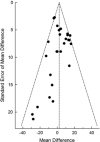Effect of ethnicity on glycaemic index: a systematic review and meta-analysis
- PMID: 26168085
- PMCID: PMC4521176
- DOI: 10.1038/nutd.2015.21
Effect of ethnicity on glycaemic index: a systematic review and meta-analysis
Abstract
Objectives: Low glycaemic index (GI) foods are recommended to improve glycaemic control in diabetes; however, Health Canada considers that GI food labeling would be misleading and unhelpful, in part, because selected studies suggest that GI values are inaccurate due to an effect of ethnicity. Therefore, we conducted a systematic review and meta-analysis to compare the GI of foods when measured in Caucasians versus non-Caucasians.
Methods: We searched MEDLINE, EMBASE and Cochrane databases for relevant articles. GI differences were aggregated using the generic inverse variance method (random effects model) and expressed as mean difference (MD) with 95% confidence intervals (95% CI). Study quality was assessed based on how well studies complied with official international GI methodology.
Results: Review of 1288 trials revealed eight eligible studies, including 28 comparisons of GI among 585 non-Caucasians and 971 Caucasians. Overall, there was borderline significant evidence of higher GI in non-Caucasians than Caucasians (MD, 3.3 (95% CI, -0.1, 6.8); P=0.06) with significant heterogeneity (I(2), 46%; P=0.005). The GI of eight types of rice was higher in non-Caucasians than Caucasians (MD, 9.5 (95% CI, 3.7, 23.1); P=0.001), but there was no significant difference for the other 20 foods (MD, 1.0 (95% CI, -2.5, 4.6); P=0.57). MD was significantly greater in the four low-quality studies (nine comparisons) than the four high-quality studies (19 comparisons; 7.8 vs 0.7, P=0.047).
Conclusions: With the possible exception of rice, existing evidence suggests that GI values do not differ when measured in Caucasians versus non-Caucasians. To confirm these findings high-quality studies using a wide range of foods are required.
Figures



Similar articles
-
Inhaled corticosteroids in children with persistent asthma: effects on growth.Evid Based Child Health. 2014 Dec;9(4):829-930. doi: 10.1002/ebch.1988. Evid Based Child Health. 2014. PMID: 25504972
-
Evaluation of Various Starchy Foods: A Systematic Review and Meta-Analysis on Chemical Properties Affecting the Glycemic Index Values Based on In Vitro and In Vivo Experiments.Foods. 2021 Feb 8;10(2):364. doi: 10.3390/foods10020364. Foods. 2021. PMID: 33567535 Free PMC article.
-
Potential contributions of the methodology to the variability of glycaemic index of foods.World J Diabetes. 2021 Feb 15;12(2):108-123. doi: 10.4239/wjd.v12.i2.108. World J Diabetes. 2021. PMID: 33594331 Free PMC article. Review.
Cited by
-
Individual variations in glycemic responses to carbohydrates and underlying metabolic physiology.Nat Med. 2025 Jul;31(7):2232-2243. doi: 10.1038/s41591-025-03719-2. Epub 2025 Jun 4. Nat Med. 2025. PMID: 40467897 Free PMC article.
-
Glycemic Index and Insulinemic Index of Foods: An Interlaboratory Study Using the ISO 2010 Method.Nutrients. 2019 Sep 13;11(9):2218. doi: 10.3390/nu11092218. Nutrients. 2019. PMID: 31540317 Free PMC article.
-
Discharge pharmacotherapy for Type 2 diabetic inpatients at two hospitals of different tiers in Zhejiang Province, China.PLoS One. 2020 Apr 8;15(4):e0230123. doi: 10.1371/journal.pone.0230123. eCollection 2020. PLoS One. 2020. PMID: 32267843 Free PMC article.
-
Raman Fingerprints of Rice Nutritional Quality: A Comparison between Japanese Koshihikari and Internationally Renowned Cultivars.Foods. 2021 Nov 29;10(12):2936. doi: 10.3390/foods10122936. Foods. 2021. PMID: 34945487 Free PMC article.
-
Ethnic Variability in Glucose and Insulin Response to Rice Among Healthy Overweight Adults: A Randomized Cross-Over Study.Diabetes Metab Syndr Obes. 2023 Apr 9;16:993-1002. doi: 10.2147/DMSO.S404212. eCollection 2023. Diabetes Metab Syndr Obes. 2023. PMID: 37063254 Free PMC article.
References
-
- Wolever TMS. Is glycaemic index (GI) a valid measure of carbohydrate quality. Eur J Clin Nutr. 2013;67:522–531. - PubMed
-
- Dworatzek PD, Arcudi K, Gougeon R, Husein N, Sievenpiper JL, Williams SL. Canadian Diabetes Association 2013 clinical practice guidelines for the prevention and management of diabetes in Canada: nutrition therapy. Can J Diabetes. 2013;37:S45–S55. - PubMed
-
- Aziz A, Dumais L, Barber J. Health Canada's evaluation of the use of glycemic index claims on food labels. Am J Clin Nutr. 2013;98:269–274. - PubMed
-
- Wolever TMS, Brand-Miller JC, Abernethy J, Astrup A, Atkinson F, Axelsen M, et al. Measuring the glycemic index of foods: interlaboratory study. Am J Clin Nutr. 2008;87:S247–S257. - PubMed
-
- Pratt M, Lightowler H, Henry CJ, Thabius C, Wils D, Guérin-Deremaux L. No observable differences in glycemic response to maltitol in human subjects from 3 ethnically diverse groups. Nutr Res. 2011;31:223–228. - PubMed
LinkOut - more resources
Full Text Sources
Other Literature Sources

